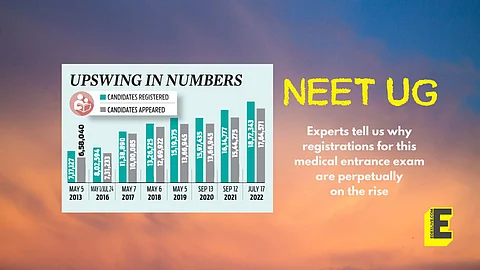

NEET UG registrations are seen rising drastically over the years, since its introduction in 2016. This year, over a whopping 21 lakh applications have been received by NTA, as opposed to 18,72,343 in 2022. This makes the already tough exam tougher to crack. Not to mention, the rising number of applicants implies the rising importance of the exam.
The foremost reason, students and experts concur, is the craze for the medical profession. According to Gaurav Tyagi, an expert in NEET, the 'doctor' tag is associated with money, power and prestige. However, other lesser-known factors contribute to the surge in registrations as well.
Lack of awareness
Students who are currently in Classes IX and X are unaware of the career options available after Science, Tyagi explains. Experts note that there is a typical mentality among students and their parents that if they have to choose between taking admission to a BSc course or appearing for JEE and NEET. This sometimes results in parents forcing their wards towards either entrance test, even if the students are not interested.
"The force factor comes into play even more in the case of NEET," tells Dr Vivek Pandey, a medical education activist. "That is because a doctor's profession is considered noble. There is respect attached to it and the salary is good," he continues.
Sustainability
The fact that a doctor works independently and can earn money after an MBBS degree through private practice also attracts a lot of people, the experts point out. They add that the prospect of a bright and sustainable future, which gives students a chance to earn throughout their lives, makes them consider being a doctor.
Saturation of jobs in Engineering
With social pressure to choose between engineering or medical for science students, the saturation of jobs in the former field diverts more students towards the medical field. "The craze for Engineering present in the early part of the 21st century has died down, giving rise to the craze for the doctor's profession," concludes Himanshu Borah, President of AIJNSA (All India JEE NEET Students' Association).
Rise of Science-takers
The number of students opting for science has risen individually in all the states, the experts tell. "The number of students studying Biology has also gone up," says Jayaprakash Gandhi, career consultant. This leads to more students trying out their talents in the NEET exam.
Government's intervention
Dr Pandey explains the number of examinees has gone up since 2016 when AIPMT was replaced with NEET. "With AIMPT, not many students from the state boards were confident enough to take the exam, but that changed with NEET," he tells.
Himanshu additionally states the NTA and Centre have created an image of the JEE and NEET exams in a way that the students feel they have to attempt them. "The Centre's statements about the coaching opportunities offered, individual coaching centres' advertisements and the hype over the exams influence the students to register," he says.
Repeaters add up
Gandhi points out that in the last two to three years, because of the pandemic, the number of repeaters has greatly increased, adding to the number of total registrations. COVID-19 is not responsible alone, however, and NEET being a tough exam also contributes to the number of increasing repeaters, explains Tyagi.
"About 16 lakh students appear for it, but the pass percentage is lower than 0.1, as only 60,000-70,000 students qualify," Himanshu says. "The seats are also limited. There are about one lakh seats in India, including those in private medical colleges," adds Dr Pandey.
Infrastructural complexities
"The increasing number of seats due to an increasing number of medical colleges makes students believe that the competition would be less, another reason for the increasing number of applicants," says Gandhi, adding, "But it is not so, the competition is also increasing."
The facilities offered at the new government colleges are insufficient, as a result of which students prefer the old colleges, and seats in the new colleges remain vacant, Himanshu explains. This also contributes to the rising number of droppers.
